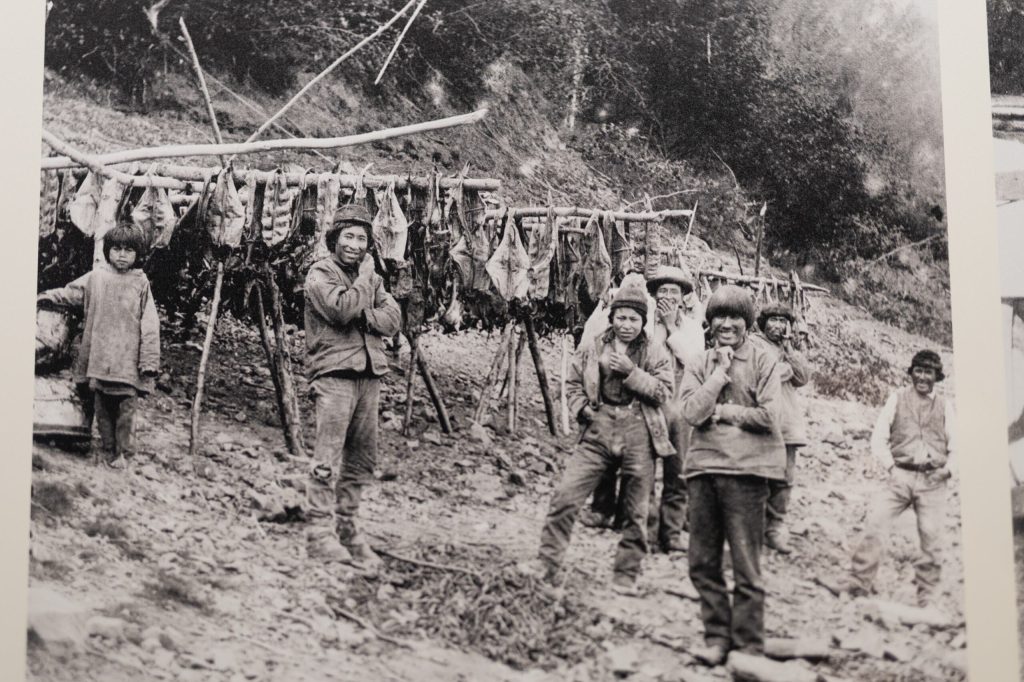
The Perilous Journey
An estimated 100,000 travellers set off for the Klondike, but only a third completed the arduous journey.
The wealthiest travellers could make the entire trip by steamboat; the majority took one of the “poor man trails” from the Alaskan coast. Relying heavily on Tlingit and Tagish packers to help them cross the coastal mountains with all their provisions, the stampeders had two options: the steep and snowy Chilkoot Trail from Dyea or the much longer White Pass from Skagway.
Both trails crossed into Canada and converged at Lake Bennett, where the gold seekers set up camps to build boats from local timber. These makeshift boats had to survive the rigorous 800 kilometres of river travel along the Yukon, an anglicized name that approximates the words “Great River” in several Indigenous languages. The frenzied building of boats decimated nearby forests, with more than 7,000 boats of every size heading down the Yukon in the summer of 1898.

Over the Mountains
To reach the goldfields, prospectors had to navigate one of two mountain passes. Miners could climb 1,500 steps, painstakingly carved out of the frozen winter slope on the Chilkoot Trail, taking the “Golden Staircase” to the summit.
Or they could take the White Pass trail, which was flat enough for pack animals to enter. But because of the steep, narrow paths, the muddy canyons below became clogged with thousands of dead horses, earning it the nickname “Dead Horse Trail.”
Fewer gold seekers opted for the longer “all-Canadian route” from Edmonton or the “Ashcroft route” from Seattle, but these inland routes proved just as dangerous. Lesser-known trails, such as the Dalton, Stikine/Teslin, and Takou trails, were also fraught with life-threatening challenges. Gold seekers were heavily laden with gear and unaccustomed to the cold climate. They suffered from snow blindness, malnutrition, contagious diseases, and delirium. Many lost their lives, and many more were forced to turn back.

Down the River
For gold seekers heading down the Yukon River in boats and rafts, the area approaching Whitehorse in traditional Kwanlin Dün territory proved to be the riskiest part of the journey.
During the early days of the gold rush, hundreds of boats were torn to pieces as stampeders attempted to pass the invisible whirlpool at Miles Canyon and the turbulent Whitehorse Rapids that followed.
In response, the North-West Mounted Police introduced safety rules that required boats to hire licensed pilots. The most skilled and trusted were the Indigenous river pilots, who were in high demand. The police also assigned a number to each boat and recorded passengers’ names to facilitate the identification of dead bodies. Long lineups formed as the stampeders waited to hire an available pilot. The young Jack London helmed his party’s boat through these treacherous waters, an experience that later informed his writings of Klondike fiction.

Cultural Collisions
As the teeming crowds converged in the Yukon, these multitudes displaced the Tr’ondëk Hwëch’in, Tlingit, Tagish, and many other Indigenous Peoples, simultaneously exposing them to contagious diseases.
The uninvited newcomers built booming gold rush towns over key Indigenous gathering sites along the main routes to the goldfields, forcing many Indigenous communities to relocate and quickly exhausting local resources, including fish and game.
Most travellers’ narratives gloss over this history of dispossession and forced dispersal. Instead, they reveal an insatiable curiosity for Indigenous cultures, racially objectified and framed through the prejudiced views of those with little knowledge or appreciation of the North. European and American travellers, in particular, took photos of what they considered the most intriguing elements of the local Indigenous communities, including their clothing, handicrafts, and hunting practices.
These images, framed through the eyes of outsiders, provide an archival record of the settler-colonial gaze on the many Indigenous villages, hunting sites, and fishing camps that thrived in the region.